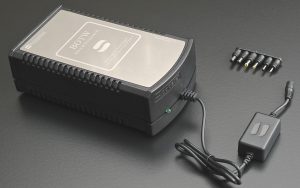 Bon nombre d’appareils audio sont fournis avec des horribles alimentations à découpage. Ce type d’alimentation permet de réduire le coût de vente mais, en contrepartie, empêche de réaliser le plein potentiel de vos appareils. SBooster fabrique des alimentations électriques linéaires avec des transformateurs de qualité audiophile. Vous avez ainsi une solution élégante permettant de remplacer très avantageusement votre adaptateur mural par une vraie alimentation secteur haut-de-gamme, comme les meilleures électroniques audiophiles.
Bon nombre d’appareils audio sont fournis avec des horribles alimentations à découpage. Ce type d’alimentation permet de réduire le coût de vente mais, en contrepartie, empêche de réaliser le plein potentiel de vos appareils. SBooster fabrique des alimentations électriques linéaires avec des transformateurs de qualité audiophile. Vous avez ainsi une solution élégante permettant de remplacer très avantageusement votre adaptateur mural par une vraie alimentation secteur haut-de-gamme, comme les meilleures électroniques audiophiles.
Les alimentations BOTW filtrent le courant dès son entrée, avant même le passage dans l’énorme transformateur toroïdal. Ainsi les pollutions RFI sont immédiatement réduites. Les circuits de ces alimentations au design novateur permettent jusqu’à 50% de gain de courant tout en consommant jusqu’à 35% de moins comparé à bien d’autre solutions de substitution. Les alimentations linéaires SBooster sont disponibles en 6 modèles avec 11 tensions de sortie (5 V à 24 V) et sont livrées avec un grand nombre de connecteurs interchangeables.
Prix suggéré : $449 à $519.
Les alimentations SBooster sont compatibles avec certains produits de marques : Antelope Audio, Antipodes, Apogee, Arcam, Audio Engine, Auralic, Bel Canto, Beresford, Bryston, Cambridge, Chord, Dynaudio, Dynavector, Graham Slee, iFi Audio, Innuos, Lindemann, Logitech, Lumin, M2Tech, Martin Logan, Meridian, Moon, Musical Fidelity, Naim, Pathos, Pro-Ject, SOtM, Wadia, Weiss, Wyre4sound.
“Toward the end of this review, Mark sent a new Sbooster PSU for me to try. He claimed that the sound of the (Lumin) D1 with the Sbooster would elevate performance levels to new heights. Boy, was he right. With the Sbooster powering the tiny D1, two features of the sound stood out in stark relief.
First, the sound became more relaxed. By “relaxed” I do not mean to imply a softening of musical transients. Instead, the Sbooster allowed the D1 to reproduce musical transients and decays in a more natural, fluid, and convincing way. Coherence, cohesion, tonal suppleness, and instrumental warmth all increased noticeably. Stated another way, I found it easier to step into and lose myself in the performance. Second, soundstage depth and imaging specificity dramatically improved. Without the Sbooster, the D1 produced airy images that seemed to float ethereally, but without much in the way of stage depth. With the Sbooster doing the driving, instruments and voices gained in solidity and three-dimensionality. Soundstage depth cues improved markedly, as did my ability to discern the placement of instruments and voices within the recorded stage. This newfound solidity had the net effect of heightening the sense of overall musical realism and involvement.” — Positive-feedback.com
